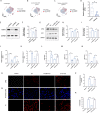The microRNA-211-5p/P2RX7/ERK/GPX4 axis regulates epilepsy-associated neuronal ferroptosis and oxidative stress
- PMID: 38191407
- PMCID: PMC10773122
- DOI: 10.1186/s12974-023-03009-z
The microRNA-211-5p/P2RX7/ERK/GPX4 axis regulates epilepsy-associated neuronal ferroptosis and oxidative stress
Abstract
Ferroptosis is an iron-dependent cell death mechanism involving the accumulation of lipid peroxides. As a critical regulator, glutathione peroxidase 4 (GPX4) has been demonstrated to be downregulated in epilepsy. However, the mechanism of ferroptosis in epilepsy remains unclear. In this study, bioinformatics analysis, analysis of epilepsy patient blood samples and cell and mouse experiments revealed strong associations among epilepsy, ferroptosis, microRNA-211-5p and purinergic receptor P2X 7 (P2RX7). P2RX7 is a nonselective ligand-gated homotrimeric cation channel, and its activation mainly increases neuronal activity during epileptic seizures. In our study, the upregulation of P2RX7 in epilepsy was attributed to the downregulation of microRNA (miR)-211-5p. Furthermore, P2RX7 has been found to regulate GPX4/HO-1 by alleviating lipid peroxidation induced by suppression of the MAPK/ERK signaling pathway in murine models. The dynamic decrease in miR-211-5p expression induces hypersynchronization and both nonconvulsive and convulsive seizures, and forebrain miR-211-5p suppression exacerbates long-lasting pentylenetetrazole-induced seizures. Additionally, in this study, induction of miR-211-5p expression or genetic-silencing of P2RX7 significantly reduced the seizure score and duration in murine models through the abovementioned pathways. These results suggest that the miR-211-5p/P2RX7 axis is a novel target for suppressing both ferroptosis and epilepsy.
Keywords: Bioinformatics technology; Epilepsy; Ferroptosis; MAPK signaling pathways; P2RX7; microRNA-211-5p.
© 2024. The Author(s).
Conflict of interest statement
The authors declare no competing interests.
Figures








References
-
- Kwan P, Arzimanoglou A, Berg AT, Brodie MJ, Allen Hauser W, Mathern G, Moshe SL, Perucca E, Wiebe S, French J. Definition of drug resistant epilepsy: consensus proposal by the ad hoc Task Force of the ILAE Commission on Therapeutic Strategies. Epilepsia. 2010;51:1069–1077. doi: 10.1111/j.1528-1167.2009.02397.x. - DOI - PubMed
MeSH terms
Substances
Grants and funding
- 2021M693825/China Postdoctoral Science Foundation
- 2021B17/Research and Innovation Fund of the First Affiliated Hospital of Harbin Medical University
- 2022-YKKWF-0270/Fundamental Research Fund for the Heilongjiang Universities
- LH2023H029/Natural Science Foundation of Heilongjiang Province
- 62072143/National Natural Science Foundation of China
LinkOut - more resources
Full Text Sources
Medical
Research Materials
Miscellaneous

